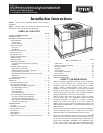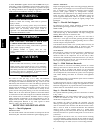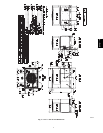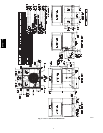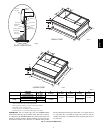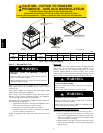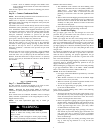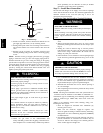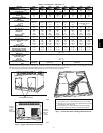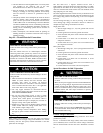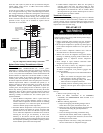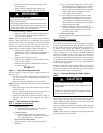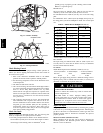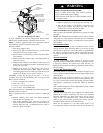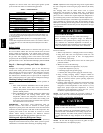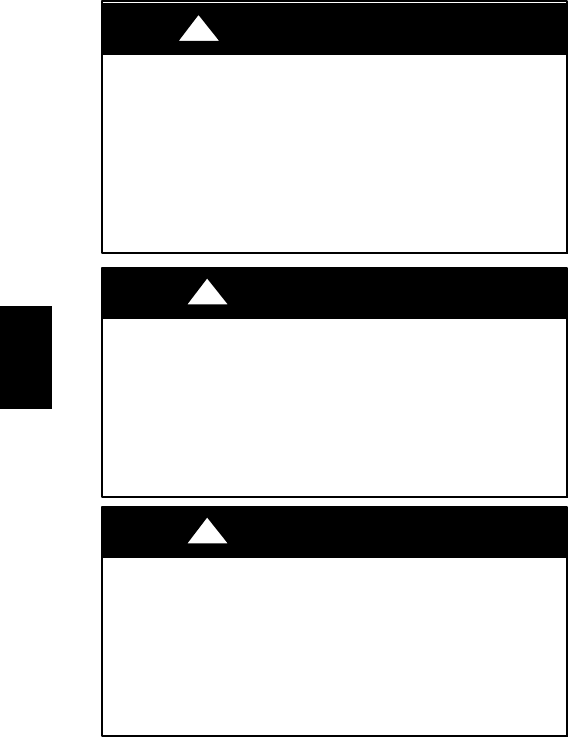
2
or death. WARNING signifies hazards which could result in per-
sonal injury or death. CAUTION is used to identify unsafe practic-
es which may result in minor personal injury or product and prop-
erty damage. NOTE is used to highlight suggestions which will
result in enhanced installation, reliability, or operation.
ELECTRICAL SHOCK HAZARD
Failure to follow this warning could result in personal
injury or death.
Before installing or servi cing system, always tur n off main
power to system. There may be more than one disconnect
switch. Turn off accessory heater power sw itch if
applicable. TAG THE DISCONNECT SWITCH WITH A
SUITABLE WARNING LABEL.
!
WARNING
FIRE, EXPLOSION, ELECTRICAL SHOCK AND
CARBON MONOXIDE POISONING HAZARD
Failure to follow this warning could result in personal
injury, death or pro perty dam age.
A qualified installer or agency must use only
factory--authorized kits or accessories when modifying thi s
product.
WARNING
!
CUT HAZARD
Failure to follow this caution may result in persona l injur y.
When remo ving access panels (see Fig. 19) or performing
maintenance functions inside your unit, be aware of sharp
sheet metal parts and screws. Although special care is taken
to reduce sharp edges to a minimum, be extremely careful
when handling parts or reaching into the unit.
CAUTION
!
INTRODUCTION
The 677C ----A unit (see Fig. 1) is a fully self-- contained,
combination Category I gas heating/electric heating a nd coolin g
unit designed for outdoor installation (See Fig. 2 and 3 for unit
dimensions). All unit sizes have return and discharge openings for
both horizontal and downflow configurations, and are factory
shipped with all downflow duct openings covered. Units may be
installed either on a rooftop, a cement slab, or directly on the
ground, if local codes permit (See Fig. 4 for roof curb dimensions).
Mode ls with an N in the thirteenth po sition of the model number
are dedicated Low NOx units designed for California installations.
These models meet the California maximum oxides of nitrogen
(NOx) emissions requirements of 40 nanograms/joule or less as
shipped from the factory and must be installed in California Air
Quality Management Districts or any ot her regions in North
America where a Low NOx rule exists.
RECEIVING AND INSTALLATION
Step 1 — Check Equipment
IDENTIFY UNIT
The unit model number and serial number are stamped on the unit
information plate. Ch eck this information against shipping papers.
INSPECT SHIPMENT
Inspect for shipping damage before removing packaging materials.
If unit appears to be dam aged or is torn loose from its anchorage,
have it examined by transportation inspectors before removal.
Forward claim papers directly to transportation company.
Manufacturer is not responsible for any damage incurred in transit.
Check all items against shipping list. Immediately notify the
nearest equipment distribution office if any item is missing. To
prevent lo ss or damage, leave all pa rts in original packages until
installation.
Step 2 — Provide Unit Support
For hurricane tie downs, contact distributor for details and PE
(Professional Engineering) Certificate if required.
ROOF CURB
Install accessory roof curb in accordance with instructions shipped
with curb (See Fig. 4). I nstall insulation, cant strips, roofing, and
flashing. Ductwork must be attached to curb.
IMPORTANT: The gasketing of the unit to the roof curb is
critical for a water tight seal. I nstall ga sketing material supplied
with the roof curb. Improperly applied gasketing also can result in
air leaks and poor unit performance.
Curb should be level to within 1/4 in. (6 mm). This is necessary for
uni t drain to func tion properly. Refer to accessory roof curb
installation instructions for additional information as required.
SLAB MOUNT
Place the unit on a solid, level concrete pad that is a minimum of 4
in. (102 mm) thick with 2 in. (51 mm) above grade. The slab
should be flush on the compressor end of the unit (to allow
condensate drain installation) and should extend 2 in. (51 mm) on
the three remaining sides of the unit. Do not secure the unit t o the
slab except when required by local codes.
Step 3 — Field Fabricate Ductwork
Secure all ducts to roof curb and build ing structure on vertical
discharge units. Do not connect ductwork to unit. For horizontal
applications, unit is provided with flanges on the horizontal
openings. All ductwork should be secured to the flanges. Insulate
and weatherproof all external ductwork, joints, and roof openings
with counter flashing and mastic in accordance with applicable
codes.
Ducts passing through an unconditioned space must be insulated
and covered with a vapor barrier.
If a plenum return is used on a vertical unit, the return should be
ducted through the roof deck to comply with applicable fire codes.
Read unit rating plate for any required clearances around ductwork.
Cabinet return--a ir static shall not exceed --.25 IN. W.C.
Step 4 — Provide Clearances
The required minimum operating and service clearances are shown
in Fig. 2 and 3.
IMPORTANT: Do not restrict outdoor airflow. An air restriction
at either the outdoor--air inlet or the fan discharge may be
detrimental t o compr essor life.
The condenser fan pulls air through the condenser coil and
discharges it through the top grille. Be sur e that the fan discharge
does not recirculate to the condenser coil. Do not locate the unit in
either a corner or under an overhead obstruction. The minimum
clearance under a partial overhang (such as a normal house
overhang) is 48-- in. (1219 mm) above the unit top. The maximum
hor izontal exten sion of a pa rtial overhang mus t not exceed 48--in.
(1219 mm).
Do not place the unit where water, ice, or snow from an overhang
or roof will damage or flood the unit. Do not install the unit on
carpeting or other com bustible materials. The uni t may be installed
on wood flooring or on Class A, B, or C roof covering materials.
677C-- --A



